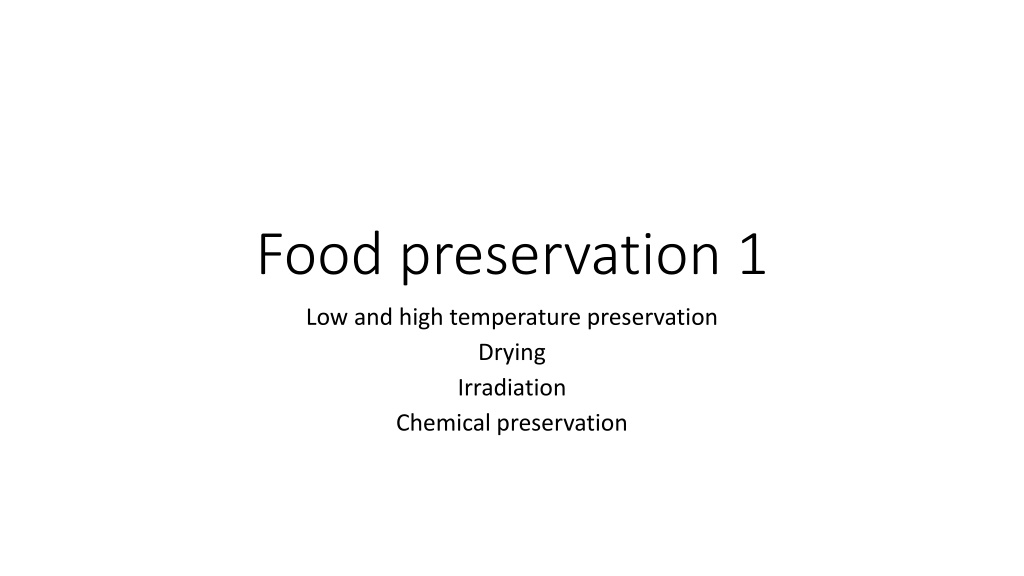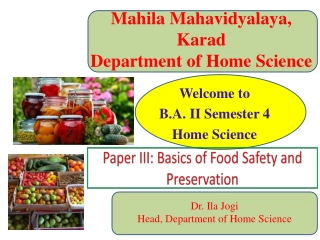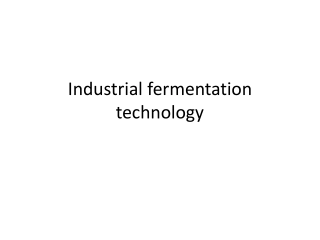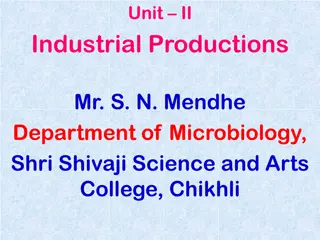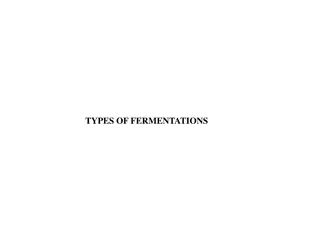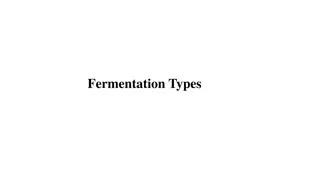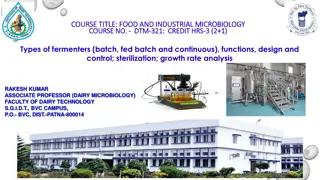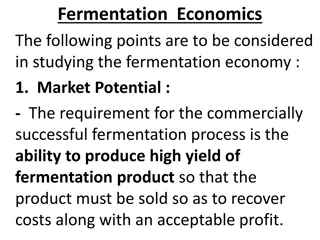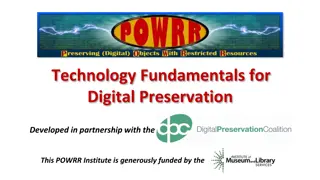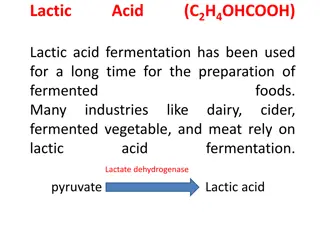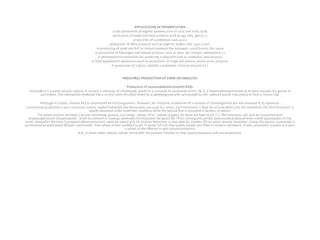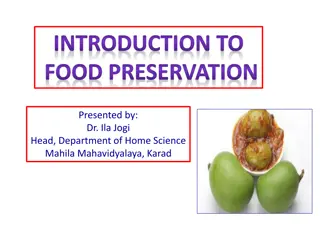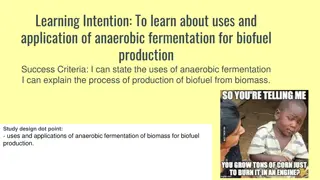Understanding Fermentation as a Food Preservation Technique
Fermentation is a natural process where microorganisms alter the sensory and functional properties of food to create a desirable end product. This method not only extends shelf life but also improves nutritional value, aids digestibility, and enhances food safety. Fermentation does not require expensive equipment and can be beneficial in developing countries. It reduces antinutrients and cooking time while enhancing the sensory qualities of foods.
Download Presentation

Please find below an Image/Link to download the presentation.
The content on the website is provided AS IS for your information and personal use only. It may not be sold, licensed, or shared on other websites without obtaining consent from the author. Download presentation by click this link. If you encounter any issues during the download, it is possible that the publisher has removed the file from their server.
E N D
Presentation Transcript
Food preservation 1 Low and high temperature preservation Drying Irradiation Chemical preservation
Food Preservation Food preservation involves the action taken to maintain foods with the desired properties or nature for as long as possible. The main reasons for food preservation are to overcome inappropriate planning in agriculture, produce value-added products, and provide variation in diet. In food preservation, the important points that need to be considered are The desired level of quality The preservation length The group for whom the products are preserved
Based on the mode of action, the major food preservation techniques can be categorized as (1) slowing down or inhibiting chemical deterioration and microbial growth e.g Low-temperature storage, Reduction of water activity, Decrease of oxygen, Increase of carbon dioxide, Acidification, Fermentation, Adding preservatives, Adding antioxidants, Control of pH, Freezing, Drying, Concentration, Surface coating, Structural modifications, Chemical modifications, Gas removal, Changes in phase transition, Hurdle technology, (2) directly inactivating bacteria, yeasts, molds, or enzymes e.g Sterilization, Pasteurization, Irradiation, Electrifying, Pressure treatment, Blanching, Cooking, Frying, Extrusion, Light Sound, Magnetic field (3) avoiding recontamination before and after processing e.g Packaging, Hygienic processing, Hygienic storage, Aseptic processing, HACCP, GMP, ISO 9000, TQM, Risk analysis and management
Fermentation Fermentation could be described as a process in which microorganisms change the sensory (flavor, odor, texture, etc.) and functional properties of a food to produce an end product that is desirable to the consumer. Fermented foods were developed simultaneously by many cultures for two main reasons: (i) to preserve harvested or slaughtered products, which were abundant at certain times and scarce at others and (ii) to improve the sensory properties of an abundant or unappealing produce. Examples of fermented foods, substrate and organism involved are: Food Wine Beer Cider Bread Yogurt Cheese Buttermilk Kefir Vinegar Tempeh Soy sauce Sauerkraut Fermented sausages Meat Substrate Organism(s) involved Grapes Yeasts Barley Yeasts Apples Yeasts Wheat Yeasts Milk LAB Milk LAB Milk LAB Milk LAB+ yeasts Grapes Yeasts followed by Acetobacter or Gluconobacter Soybeans Molds Soybeans Molds + LAB + yeasts Cabbage LAB LAB+ molds
Fermentation as a Preservation Method-Benefits Fermentation is effective at extending the shelf life of foods It can often be carried out with relatively inexpensive, basic equipment. Therefore, it remains a very appropriate method for use in developing countries and rural communities with limited facilities. It reduces antinutrients of foods, thereby increasing their safety for consumption It reduces cooking time It leads to a release of minerals such as iron, calcium, phosphorus in foods and thereby improves the nutritional value of the food. It aids digestibility It improves the sensory properties of foods and makes them more suitable for subsequent processing Ease of storage and transportation It does not depend on the use of chemical additives but beneficial microorganisms. Fermentation employs the following principles: Minimize the level of microbial contamination onto the food, particularly from high-risk sources (asepsis) Inhibit the growth of the contaminating microflora Kill the contaminating microorganisms
Freezing Freezing Freezing provides a significant extended shelf life and has been successfully employed for long-term preservation of many foods. Freezing changes the physical state of a substance by changing water into ice when energy is removed in the form of cooling below freezing temperature. The freezing of foods slows down, but does not stop, the physicochemical and biochemical reactions that govern the deterioration of foods. During storage, there is a slow progressive change in organoleptic quality, which does not become objectionable for some time . The loss of quality of frozen foods depends primarily on storage temperature, length of storage time, and thawing procedure. Microbial growth is completely stopped below 18 C, and both enzymatic and non-enzymatic changes continue at much slower rates during frozen storage
Types of freezing 1.Freezing by Contact with a Cooled Solid: Plate Freezing In this method, the product is sandwiched between metal plates and pressure is usually applied for good contact. Plate freezers are only suitable for regular shaped materials or blocks. When the product has been frozen, hot liquid is circulated to break ice seal and defrost. Spacers should be used between the plates during freezing to prevent crushing or bulging of the package.
2.Freezing by Contact with a Cooled Liquid: Immersion Freezing In this method, food is immersed in a low-temperature brine to achieve fast temperature reduction through direct heat exchange. The fluids usually used are salt solutions (sodium chloride), sugar solutions, glycol and glycerol solutions, and alcohol solutions. The solutes used must be safe to the product in terms of health, taste, color, and flavor, and the product must be denser than fluids.
3. Freezing by Contact with a Cooled Gas A. Cabinet Freezing In this method, cold air is circulated in a cabinet where product is placed in a tray. The moisture pick-up from the product surface may deposit on the cooling coils as frost, which acts as an insulation. B. Air-Blast Freezing In this method, the temperature of food is reduced with cold air flowing at a relatively high speed This method can be further divided into tunnel freezing, belt freezing, and fluidized bed freezing, depending on how air interacts with the product.
Types of Air-blast freezing 1. Fluidized Bed Freezing A fluidized bed freezer consists of a bed with perforated bottom through which refrigerated air is blown vertically upward. The air velocity must be greater than the fluidization velocity. This freezing method is suitable for small particulate food bodies of fairly uniform size, e.g., peas, diced carrots and potatoes, corns, and berry fruits. The high degree of fluidization improves the heat-transfer rate and results in good use of floor space.
2.Belt Freezing The first mechanized air-blast freezers consisted of a wire mesh belt conveyor in a blast room for continuous product flow. Uniform product distribution over the entire belt is required to achieve uniform product contact and effective freezing. Controlled vertical airflow forces cold air up through the product layer, thereby creating good contact with the product particles and increasing the efficiency. The principal current design is the two-stage belt freezer. Temperatures used usually are 10 C to 4 C in the precool section and 32 C to 40 C in the freezing section.
3. Spiral Freezing A spiral belt freezer consists of a long belt wrapped cylindrically in two tiers, thus requiring a minimal floor space. The spiral freezer uses a conveyor belt that can be bent laterally. It is suitable for products with a long freezing time (generally 10 min to 3 h), and for products that require gentle handling during freezing. It also requires a spatial air-distribution system. 4. Tunnel Freezing In this process, products are placed in trays or racks in a long tunnel and cool air is circulated over the product.
4. Cryogenic freezing In cryogenic freezing, liquefied gases are placed in direct contact with the foods. Food is exposed to an atmosphere below 60 C through direct contact with liquid nitrogen or liquid carbon dioxide or their vapor . This is a very fast method of freezing; thus, adequate control is necessary for achieving quality products. It also provides flexibility by being compatible with various types of food products and having low capital cost. The rapid formation of small ice crystals greatly reduces the damage caused by cell rupture, preserving color, texture, flavor, and nutritional value. The rapid freezing also reduces the evaporative weight loss from the products, provides high product throughput, and has low floor space requirements
Drying The main reason for drying a food is to extend its shelf life beyond that of the fresh material, without the need for refrigerated transport and storage. This goal is achieved by reducing the available moisture, or water activity to a level which inhibits the growth and development of spoilage and pathogenic microorganisms, reducing the activity of enzymes and the rate at which undesirable chemical changes occur. Drying also reduces the weight of the food product. Shrinkage, which occurs often during drying, reduces the volume of the product. These changes in weight and volume can lead to substantial savings in transport and storage costs and, in some cases, the costs of packaging. Disadvantages of drying of foods: However, dehydration is an energy intensive process and the cost of supplying this energy can be relatively high, compared to other methods of preservation.
Drying (Disadvantages) In the case of solid food pieces, shrinkage can alter the size and shape of the pieces. Changes in colour may also occur. When the food pieces are rehydrated, their colour and texture may be significantly inferior to those of the fresh material. Dry powders may be slow to rehydrate. Changes in flavour may occur during drying solid or liquid foods, as a result of losing volatile flavour compounds and/or the development of cooked flavours. A reduction in the nutritional value of foods can result from dehydration. In particular, loss of vitamins C and A may be greater during drying than in canning or freezing.
Equipment Used in Hot Air Drying of Solid Food Pieces Equipment Used in Hot Air Drying of Solid Food Pieces Cabinet (Tray) Drier This is a multipurpose, batch-operated hot air drier. It consists of an insulated cabinet, equipped with a fan, an air heater and a space occupied by trays of food. It can vary in size from a bench-scale unit holding one or two small trays of food to a large unit taking stacks of large trays. The air may be directed by baffles to flow across surface of the trays of food or through perforated trays and the layers of food, or both ways. The moist air is partly exhausted from the cabinet and partly recycled by means of dampers. Small cabinet driers are used in laboratories, while larger units are used as industrial driers, mainly for drying sliced or diced fruits and vegetables.
Tunnel Drier This type of drier consists of a long insulated tunnel. Tray loads of the wet material are assembled on trolleys which enter the tunnel at one end. The trolleys travel the length of the tunnel and exit at the other end. Heated air also flows through the tunnel, passing between the trays of food and/or through perforated trays and the layers of food. The air may flow parallel to and in the same direction as the trolleys. This is known as a concurrent tunnel. Other designs featuring countercurrent, concurrent-countercurrent and crossflow of air are available. Tunnel driers are mainly used for drying sliced or diced fruits and vegetables
Bin Drier This is a throughflow drier, mainly used to complete the drying of particulate material partly dried in a tunnel or conveyor drier. It takes the form of a vessel fitted with a perforated base. The partly dried product is loaded into the vessel to up to 2 m deep. Dry, but relatively cool air, percolates up through the bed slowly, completing the drying of the product over an extended period, up to 36 h. Some migration of moisture between the particles occurs in the bin. This improves the uniformity of moisture content in the product.
Rotary Drier The most common design of rotary drier used for food application is known as the direct rotary drier. This consists of a cylindrical shell, set at an angle to the horizontal. The shell rotates at 4 5 rpm. Wet material is fed continuously into the shell at its raised end and dry product exits over a weir at the lower end. Baffles or flights are fitted to the inner surface of the shell. These lift the material up as the shell rotates and allow it to fall down through a stream of heated air, that may flow concurrent or countercurrent to the direction of movement of the material. The feed material must consist of relatively small particles, which are free-flowing and reasonably resistant to mechanical damage.
Sun and Solar Drying Sun drying is used to describe the process whereby some or all of the energy for drying of foods is supplied by direct radiation from the sun. The term solar drying is used to describe the process whereby solar collectors are used to heat air, which then supplies heat to the food by convection. For centuries, fruit, vegetables, meat and fish have been dried by direct exposure to the sun. The fruit or vegetable pieces were spread on the ground on leaves or mats while strips of meat and fish were hung on racks. While drying in this way, the foods were exposed to the challenges of the weather and to contamination by insects, birds and animals. Drying times were long and spoilage of the food could occur before a stable moisture content was attained. Pilfering was a major disadvantage Covering the food with glass or a transparent plastic material can reduce these problems.
Spray Drying This is the method most commonly used to dry liquid foods and slurries. The feed is converted into a fine mist or spray. This is known as atomisation and the spray forming device as an atomiser. The droplet size is usually in the range 10 200 m, although for some applications larger droplets are produced. The spray is brought into contact with heated air in a large drying chamber. Because of the relatively small size of the droplets, a very large surface area is available for evaporation of the moisture. Also, the distance that moisture has to migrate to the drying surface is relatively short. Hence, the drying time is relatively short, usually in the range 1 20 s. Evaporative cooling at the drying surface maintains the temperature of the droplets close to the wet bulb temperature of the drying air, i.e. most of the drying takes place under constant rate conditions. If the particles are removed quickly from the drying chamber once they are dried, heat damage is limited. Hence, spray drying can be used to dry relatively heat sensitive materials.
Spray drying Inlet fan draws air in through filter and then through heater into drying chamber. Pump delivers the feed from tank to the atomiser . This converts the feed into a spray which then contacts the heated air in drying chamber, where drying takes place. Most of the dry powder is removed from the chamber and pneumatically conveyed to a storage bin. The air leaves the chamber and passes through one or more air/powder separators to recover the fine powder carried in the air. This powder may be added to the main product stream.
